


Johann Peter Joseph Weyer (19 May 1794, Cologne - 25 August 1864, Cologne) was a German architect, most notable as city architect to the city of Cologne.



Johann Peter Joseph Weyer (19 May 1794, Cologne - 25 August 1864, Cologne) was a German architect, most notable as city architect to the city of Cologne.

Cologne is the largest city of Germany's most populous state of North Rhine-Westphalia (NRW) and the fourth-most populous city in Germany. With 3.6 million people in the urban region and 1.1 million inhabitants within its city proper, Cologne is the largest city on the river Rhine and also the most populous city of both the Rhine-Ruhr Metropolitan Region and the Rhineland. Centered on the left bank of the Rhine, Cologne is about 35 kilometres (22 mi) southeast of NRW's state capital Düsseldorf and 25 kilometres (16 mi) northwest of Bonn. It is classified as a world city by GaWC.

Soest is a city in North Rhine-Westphalia, Germany. It is the capital of the Soest district.

Heinrich Cornelius Agrippa von Nettesheim was a German polymath, physician, legal scholar, soldier, theologian, and occult writer. He is considered one of the most influential occultists of the early modern period. His book on the occult Three Books of Occult Philosophy was published in 1533, but was condemned as heretical by the inquisitor of Cologne. His work drew heavily upon the influences of Kabbalah, Hermeticism and neo-Platonism.
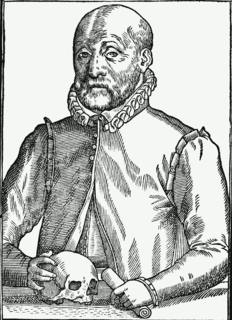
Johann Weyer or Johannes Wier was a Dutch physician, occultist and demonologist, disciple and follower of Heinrich Cornelius Agrippa.

The Deutscher Werkbund is a German association of artists, architects, designers, and industrialists, established in 1907. The Werkbund became an important element in the development of modern architecture and industrial design, particularly in the later creation of the Bauhaus school of design. Its initial purpose was to establish a partnership of product manufacturers with design professionals to improve the competitiveness of German companies in global markets. The Werkbund was less an artistic movement than a state-sponsored effort to integrate traditional crafts and industrial mass production techniques, to put Germany on a competitive footing with England and the United States. Its motto Vom Sofakissen zum Städtebau indicates its range of interest.

The Archbishop of Cologne is an archbishop representing the Archdiocese of Cologne of the Catholic Church in western North Rhine-Westphalia and northern Rhineland-Palatinate in Germany and was ex officio one of the electors of the Holy Roman Empire, the Elector of Cologne, from 1356 to 1801.
Johann, typically a male given name, is the Germanized form of the originally Hebrew language name יוחנן (Yohanan). It is a form of the Germanic and Latin given name "Johannes." The English language form is John. It is uncommon as a surname.
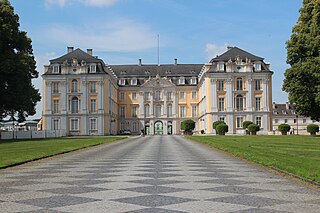
The Augustusburg and Falkenlust Palaces form a historical building complex in Brühl, North Rhine-Westphalia, Germany, which has been listed as a UNESCO cultural World Heritage Site since 1984. The buildings are connected by the spacious gardens and trees of the Schlosspark. Augustusburg Palace and its parks also serve as a venue for the Brühl Palace Concerts.
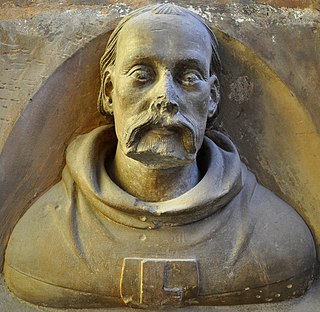
Peter Parler was a German-Bohemian architect and sculptor from the Parler family of master builders. Along with his father, Heinrich Parler, he is one of the most prominent and influential craftsmen of the Middle Ages. Born and apprenticed in the town of Schwäbisch Gmünd, Peter worked at several important late Medieval building sites, including Strasbourg, Cologne, and Nuremberg. After 1356 he lived in Prague, capital of the Kingdom of Bohemia and seat of the Holy Roman Empire, where he created his most famous works: St. Vitus Cathedral and the Charles Bridge.

Johann Maria Farina gegenüber dem Jülichs-Platz GmbH is the world's oldest eau de Cologne and perfume factory. It traces its origins to a luxury goods retail business founded in 1709 in Cologne by Giovanni Battista Farina, who was subsequently joined in the business by his younger brother, Giovanni Maria Farina. The short form 'Farina gegenüber' and the French name 'Jean Marie Farina vis-à-vis de la place Juliers' were also commonly used over a long period of time. The company's logo is a red tulip.

Gottfried Böhm is a German architect and sculptor. His reputation is based on creating highly sculptural buildings made of concrete, steel, and glass. Böhm's first independent building was the Cologne chapel "Madonna in the Rubble". Böhm's most influential and recognized building is the Maria, Königin des Friedens or Nevigeser Wallfahrtsdom.
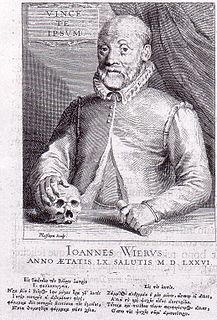
De praestigiis daemonum, translated as On the Tricks of Demons, is a book by medical doctor Johann Weyer, also known as Wier, first published in Basel in 1563. The book argues that witchcraft does not exist and that those who claim to practice it are suffering from delusions, which should be treated as mental illnesses, rather than punished as witchcraft. It was influential in the abolishment of witchcraft trials in the Netherlands.
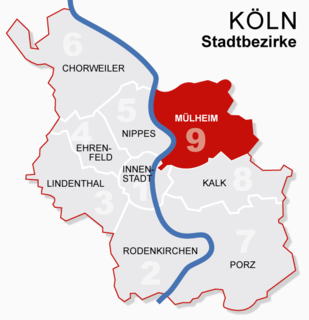
Mülheim is a city district (Stadtbezirk) of Cologne in Germany and a formerly independent town. Mülheim is located on the right bank of the Rhine opposite the old town of Cologne.
Weyer may refer to:

Villmar is a market village in the Limburg-Weilburg district in Hesse, Germany. The community is the centre for quarrying and processing the so-called Lahn Marble.

The Archdiocese of Cologne is an archdiocese of the Catholic Church in western North Rhine-Westphalia and northern Rhineland-Palatinate in Germany.

Strasbourg-Ville is the main railway station in the city of Strasbourg, Bas-Rhin, France. It is the eastern terminus of the Paris-Est–Strasbourg-Ville railway. The current core building, an example of historicist architecture of the Wilhelminian period, replaced a previous station inaugurated in 1852, later turned into a covered market and ultimately demolished.
With over 20 million passengers in 2018, Strasbourg-Ville is one of the busiest railway stations in France, second only to Lyon-Part-Dieu outside of the Île-de-France.

Brühl station is a railway station in the city of Brühl in the German state of North Rhine-Westphalia. It consists of a passenger station and a freight yard about a kilometre to the north. Both parts of the station are on the Left Rhine line ; the freight yard also has a connection via Brühl-Vochem to the Cologne port and freight railway network.
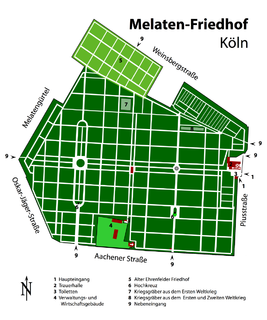
Melaten is the central cemetery of Cologne, North Rhine-Westphalia, Germany, which was first mentioned in 1243. It was developed to a large park, holding the graves of notable residents.

The siege of Rheinberg 1586–1590, also known as the capture of Rheinberg of 1590, took place at the strategic Cologne enclave of Rheinberg, one of the principal crossing-points over the Rhine on the stretch between the Electorate of Cologne and the Dutch border, between 13 August 1586 and 3 February 1590, during the Eighty Years' War, the Cologne War, and the Anglo-Spanish War (1585–1604). After an initial siege in 1586, and a long blocking by the Spanish forces until September 1589, Don Alexander Farnese, Duke of Parma (Spanish: Alejandro Farnesio), commander-in-chief of the Spanish army, sent a substantial force, under Peter Ernst, Count of Mansfeld, to besiege Rheinberg. Despite the efforts by Maarten Schenck van Nydeggen, and Sir Francis Vere, to relieve the fortress city, the Protestant garrison finally surrendered to the Spaniards on 3 February 1590.